It is well-known that considerable cross-fertilisation between the European and Japanese paperfolding traditions occurred following the establishment of the first Western-style kindergarten in Kyoto in 1875. But does this mean, as is normally assumed, that no cross-fertilisation had occurred earlier?
‘Earlier’ in this case, would mean earlier by several centuries. Until the Meiji period began in 1868, Japan had been almost entirely closed to Western trade and influence since 1639, when the 'sakoku’ or ‘locked-country’ policy came fully into force. However, before that time, beginning in 1543, European traders and missionaries had largely been welcomed. Many Japanese had been so influenced by Western ideas that they had converted to Christianity.
If cross-fertilisation had occurred during this ’open’ period, we would expect to find similar, or perhaps identical, designs in both traditions at an early date. Are there any such designs? Well, there is one, the Paper Boat.
So, the question is this: Given that we have a possible illustration of Paper Boats from Europe in 1498, and several mentions in the literature of paper boats (though not provably Paper Boats) before 1639 (see my earlier substack ‘The 1498 illustration of the Paper Boat: Conclusive Evidence or Wishful Thinking?’), is it possible that the Paper Boat design was, like Christianity, imported to Japan from Europe, and that some degree of cross-fertilisation between the two paperfolding traditions had already occurred prior to 1639?
Before trying to answer this question we should probably first look at what we know about the history of the Paper Boat in Japan to see if it offers any evidence either way. Or perhaps I should say ‘at the history of the Paper Boats’, because there seem to have been two, closely-related, but different, types of Paper Boat in the Japanese tradition. One type has only one sail (sail referring to the central internal triangle of the design) while the other has three, these three sails often being pictured as if pulled slightly apart, perhaps in order to show them more clearly.
As far as I know, the three-sailed version is first pictured in the kosode pattern book 'Shotoku hinagata' by Nishikawa Sukenobu, which was published in 1713. The illustration shows two types of model boat, one made largely of wood and the other the Paper Boat.
A very similar design can be found in another kosode pattern book by Nishikawa Sukenobu, 'Hinagata miyako fuzoku', which was published only a few years later in 1716.
The three-sailed version appears earlier, but the one-sailed version is only a little behind. It first appears in the well-known print found in ‘Ranma Zushiki' by Hayato Ohoka, which was published in 1734.
From then on this one-sailed version appears in the literature much more frequently, although admittedly often in simplified form, than the earlier three-sailed version does. Here, for instance is a detail of a kimono patterned with Paper Boats taken from the picture book 'Ehon kyoka yama mata yama' by Katsushika Hokusai which was published in 1804.
Simplified Paper Boats also appear as part of the pattern of a kimono in this print by Utagawa Kunisada, which can be dated to 1841.
Not that the three-sailed Paper Boat disappeared entirely. A variation of the design was illustrated as late as 1935 in 'Origami Moyo: Book Two' by Kawarazaki Kodo. (I apologise for the poor quality of this image. It is the best I have, but I think you should still be able to make out the three sails.)
The basic difference between these two designs seems to be the shape of paper they were folded from. If you begin from a square you will arrive at (one or other of several variations of) the three-sailed boat. If you begin from an oblong you will arrive at the one-sailed design. It seems to be as simple as that, although it is unusual in the Japanese tradition for the same design to be folded from two different paper shapes.
Could this duality of designs be evidence that the design was an import? Well, it could, if you assume that the imported design was folded from an oblong, in the normal European way, but that Japanese folders preferred to use squares and so varied it accordingly. (Most early Japanese representative paperfolding designs were folded from squares, while oblongs were commonly used for etiquettical designs such as wrappers.) On the other hand, we might equally well assume that the three-sailed Paper Boat is in fact the original (it is earlier after all), and that some unknown folder has varied it by starting from an oblong at a later date.
I like the first of these arguments, but I accept that it is hardly conclusive. Unfortunately (but not unexpectedly), the question as to whether it is possible that the Paper Boat design was, like Christianity, imported to Japan from Europe, seems impossible to answer. There is no evidence to substantiate the idea. Equally, there is no evidence to rule it out. It remains a theoretical possibility, but merely that.
However, I hope that raising this question will at least serve as a reminder that the Japanese and European paperfolding traditions are not as separate as they are often assumed to be, and that there may well prove to be more connections between them than we currently think, once all the evidence has been gathered in. Speculation is not history, but history sometimes grows out of speculation.
PS: In case you were wondering, the print at the top of this page showing 'Women in a Phoenix Boat at New Year', is by Chôbunsai Eishi and can be dated to c1793. The lady in green in the centre of the boat is holding a Paper Boat in her left hand. You have sharp eyes if you spotted this.




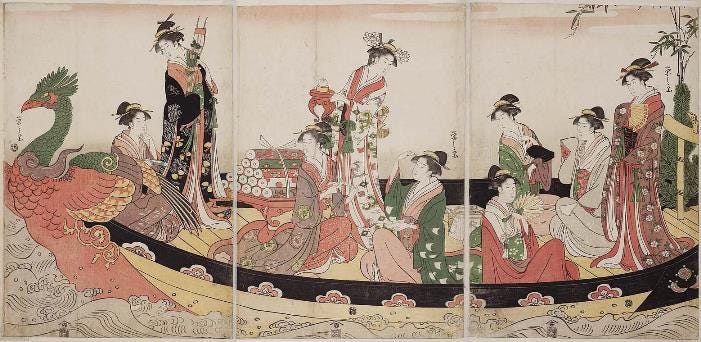

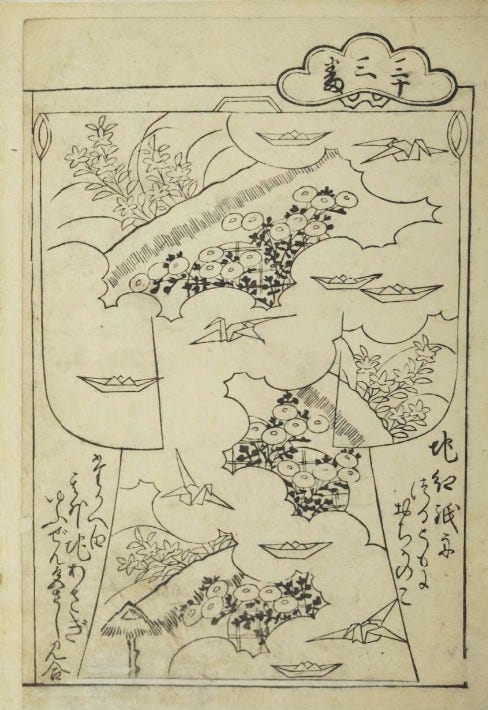
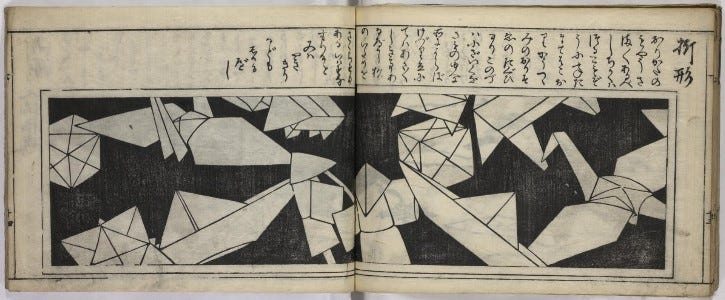
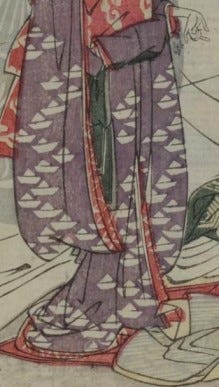
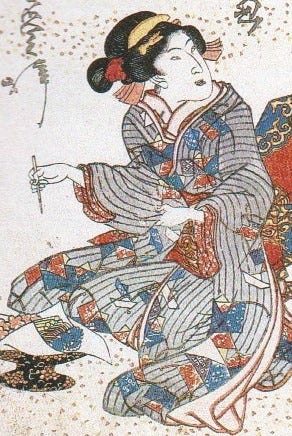


What an interesting essay! Thank you!
I agree, this is a very interesting topic. The drawings seem quite precise and consistent, and some are more like the Western version than others. Maybe there are instructions waiting to be found in some long-lost Japanese book.